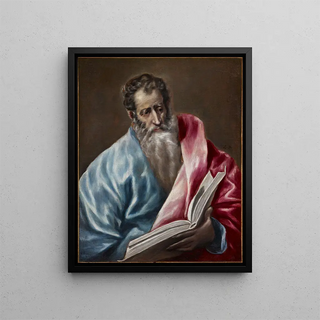Saint Matthew Painting - El Greco | Art print


View from behind

Frame (optional)
Saint Matthieu - El Greco – Captivating Introduction
Within the realm of 16th-century Spanish painting, the artwork "Saint Matthieu" by El Greco stands out for its spiritual intensity and emotional depth. This canvas, embodying the fusion of mysticism and realism, immerses us in a moment of divine revelation. The figure of Matthieu, often depicted in Christian tradition, is portrayed here with a strength and expressiveness that transcend a simple portrait. Through this piece, El Greco invites us to contemplate not only the figure of the saint but also the very essence of faith. The light emanating from the canvas seems to vibrate, illuminating the path toward spiritual understanding.
Style and uniqueness of the artwork
El Greco's style is immediately recognizable, blending elements of Italian Renaissance with a unique Spanish sensibility. In "Saint Matthieu," elongated forms and vivid colors combine to create an atmosphere that is both mystical and tangible. The saint's face, imbued with gravity, is illuminated by a soft light that accentuates his features, while the drapery of his robe, in a deep blue, appears to float with an almost ethereal lightness. The meticulous details, such as the delicate hands conveying a gesture full of meaning, add an extra dimension to the piece. This stylistic approach, characterized by intense expressivity, allows the artist to convey complex emotions, making each glance at the canvas a deeply personal experience.
The artist and his influence
Born in Crete in 1541, Doménikos Theotokópoulos, known as El Greco, made his mark with a bold artistic vision. His initial training in Greece, followed by a stay in Italy, enabled him to incorporate various styles before settling in Toledo, where he left an indelible mark. El Greco was able to capture the essence of the human soul through works that express not only spirituality but also the torments and aspirations of his time. His influence extends far beyond his era, inspiring generations of artists, from Romanticism to Impressionism.

Matte finish

View from behind

Frame (optional)
Saint Matthieu - El Greco – Captivating Introduction
Within the realm of 16th-century Spanish painting, the artwork "Saint Matthieu" by El Greco stands out for its spiritual intensity and emotional depth. This canvas, embodying the fusion of mysticism and realism, immerses us in a moment of divine revelation. The figure of Matthieu, often depicted in Christian tradition, is portrayed here with a strength and expressiveness that transcend a simple portrait. Through this piece, El Greco invites us to contemplate not only the figure of the saint but also the very essence of faith. The light emanating from the canvas seems to vibrate, illuminating the path toward spiritual understanding.
Style and uniqueness of the artwork
El Greco's style is immediately recognizable, blending elements of Italian Renaissance with a unique Spanish sensibility. In "Saint Matthieu," elongated forms and vivid colors combine to create an atmosphere that is both mystical and tangible. The saint's face, imbued with gravity, is illuminated by a soft light that accentuates his features, while the drapery of his robe, in a deep blue, appears to float with an almost ethereal lightness. The meticulous details, such as the delicate hands conveying a gesture full of meaning, add an extra dimension to the piece. This stylistic approach, characterized by intense expressivity, allows the artist to convey complex emotions, making each glance at the canvas a deeply personal experience.
The artist and his influence
Born in Crete in 1541, Doménikos Theotokópoulos, known as El Greco, made his mark with a bold artistic vision. His initial training in Greece, followed by a stay in Italy, enabled him to incorporate various styles before settling in Toledo, where he left an indelible mark. El Greco was able to capture the essence of the human soul through works that express not only spirituality but also the torments and aspirations of his time. His influence extends far beyond his era, inspiring generations of artists, from Romanticism to Impressionism.
12,34 €






